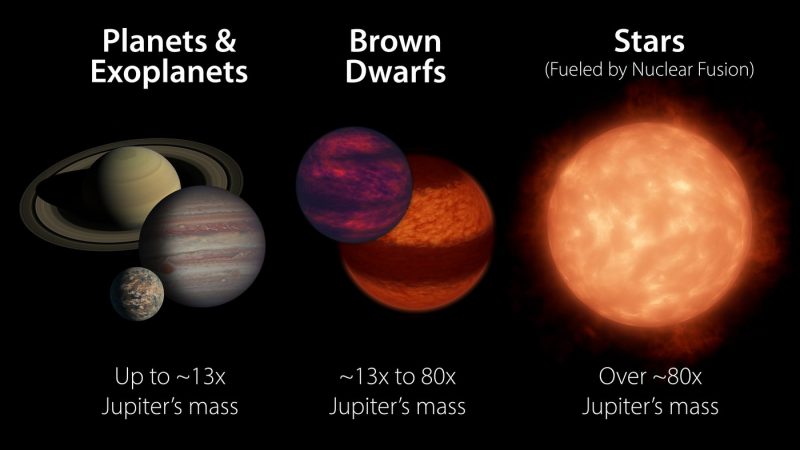- Brown dwarfs are ‘failed stars’ with masses greater than planets but less than stars. The first confirmed brown dwarf was Gliese 229 B in 1995.
- But Gliese 229 B’s brightness is puzzling. Based on its mass, it should be much brighter, said astronomers.
- Now, astronomers say Gliese 229 B is two brown dwarfs, not one, as they originally thought. The researchers said the two brown dwarfs orbit extremely close together.
First-known brown dwarf is really twins
In 1995, astronomers announced the discovery of the first-known brown dwarf, Gliese 229 B. Brown dwarfs are failed stars: more massive than the largest planets, but not large enough to begin fusion and shine as stars. Yet Gliese 229 B was a little strange. It’s dimmer than it should be, given its mass. On October 16, 2024, two Caltech-led teams said Gliese 229 B is not a single brown dwarf but twins. The pair orbit each other so closely that their dual nature remained undetected for 29 years.
The scientists published their results in two papers. The peer-reviewed journal Nature published the first paper on October 16, 2024. And the peer-reviewed journal The Astrophysical Journal Letters published the second paper on October 16, 2024.

First-known brown dwarf was mysterious
A team of Caltech researchers first discovered Gliese 229 B in 1995, orbiting a red dwarf star 19 light-years away. With a mass about 70 times that of Jupiter, Gliese 229 B was far heavier than scientists think a planet can be. But Gliese 229 B’s atmosphere contained methane … not uncommon for a gas giant planet, but strange for a star. They’d found the missing link between planets and stars – a brown dwarf – theorized to exist since the 1960s.
Fast-forward to 2024, and scientists have discovered several thousand of these star-planet hybrids. But even after decades of observations, a mystery surrounding Gliese 229 B has persisted. Given its a huge mass, the brown dwarf doesn’t shine as brightly as scientists’ models predict.
Astronomers have theorized this could be explained by Gliese 229 B being a binary system, where two brown dwarfs orbit each other. But, as lead author of the new study Jerry W. Xuan explained, evidence for this has proved elusive:
To evade notice by astronomers for 30 years, the two brown dwarfs would have to be very close to each other.
A tight-knit brown dwarf binary
But now, astronomers’ suspicions are confirmed. And the two brown dwarfs making up Gliese 229 B are quite close indeed. Using two different instruments at the European Southern Observatory’s Very Large Telescope, Xuan and his team detected a brown dwarf pair separated by a distance only 16 times larger than the distance between Earth and the moon. The pair are so close that they zoom around each other in just 12 days.
The newly named brown dwarfs Gliese 229 Ba and Gliese 229 Bb weigh about 38 and 34 times the mass of Jupiter, respectively. So they add up to the roughly 70 Jupiter masses that scientists attributed to Gliese 229 B. And the brightness of the system is exactly what scientists would expect from these two smaller bodies. So the discovery seems to have solved the mystery of the Gliese 229 B’s brightness … while upending our understanding of the famous brown dwarf. Xuan said:
Gliese 229 B was considered the poster-child brown dwarf. And now we know we were wrong all along about the nature of the object. It’s not one but two. We just weren’t able to probe separations this close until now.
Watch Gliese 229 Ba and Gliese 229 Bb orbit each other.
A new field of brown dwarf study?
We’ve found binary brown dwarf systems before, but never this close together. How did this tight-knit pair of failed stars come to be? It’s a mystery. One theory says binary brown dwarfs could form when the swirling disk of gas and dust around a young star splits, creating two brown dwarf ‘seeds’. If these young brown dwarfs pass close to each other, they could become gravitationally bound, like Gliese 229 Ba and Bb.
That begs another question: If a process like this could create a brown dwarf binary, could it also create a binary pair of exoplanets? It’s an intriguing prospect. The research team is hoping to probe these questions further as they expand their search to find more closely orbiting brown dwarf binaries.
Bottom line: Gliese 229 B – the first-known brown dwarf – is really a binary system of two brown dwarfs entwined in an incredibly close orbit.
Source: The cool brown dwarf Gliese 229 B is a close binary
Source: Discovery of the Binarity of Gliese 229B, and Constraints on the System’s Properties
Via Caltech
Read more: Scorching storms on brown dwarfs revealed by Webb
Read more: Brown dwarf auroras might cause methane emission